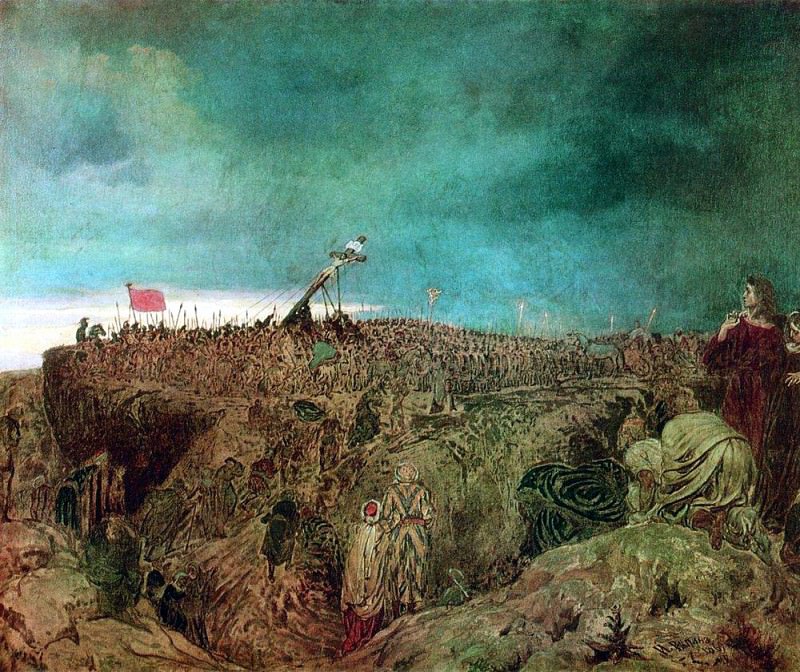Calvary (The Crucifixion of Christ) Ilya Repin (1844-1930)
Ilya Repin – Calvary (The Crucifixion of Christ)
Edit attribution
Download full size: 1000×839 px (0,2 Mb)
Painter: Ilya Repin
Repin repeatedly addressed religious themes throughout his life. "Golgotha" is a picture literally suffered by the artist, the idea of which he nurtured for many years. Reading the book of memories of Repin, you can understand how the author experienced this story, passed it through his heart. He felt and heard the cries and groans of those mourning for Christ. Under the gloomy heavy sky - countless crowds of empathizing and curious.
Description of Ilya Repin’s Golgotha
Repin repeatedly addressed religious themes throughout his life. "Golgotha" is a picture literally suffered by the artist, the idea of which he nurtured for many years.
Reading the book of memories of Repin, you can understand how the author experienced this story, passed it through his heart. He felt and heard the cries and groans of those mourning for Christ.
Under the gloomy heavy sky - countless crowds of empathizing and curious. Interestingly, Repin depicted Christ on the cross in an ordinary Russian shirt. There is still debate to this day as to why the artist employed this device, but one version is supported by most art critics.
Critics believe that the artist conveyed through the elements of clothing dramatic characteristic of the Russian people. Since the stories of biblical themes were clearer and closer to ordinary people, the language of art also became more eloquent.
An interesting fact is that Repin was not very fond of the church, treated it rather coldly. As a sign of solidarity, when Leo Tolstoy was excommunicated from it, the artist also stopped visiting the house of God. So why are there so many religious scenes in Repin’s works? The fact is that, despite his personal attitude, he presents the church to the people as a sign to the Russian people.
"Golgotha" was presented at an art exhibition in Helsinki, where it became an honorary leader among other works. This painting was quite different from the usual Repin composition.
In addition, "Golgotha" was filled with symbols, little things such as a freshly dug grave, bloody footprints, and dogs scurrying about. This was uncharacteristic of the author’s work and, along with admiration, the painting caused sincere amazement of connoisseurs.
The exhibition in Helsinki was the last in the life of the author, and "Calvary" was one of the brightest paintings of the final creative years.
Кому понравилось
Пожалуйста, подождите
На эту операцию может потребоваться несколько секунд.
Информация появится в новом окне,
если открытие новых окон не запрещено в настройках вашего браузера.
You need to login
Для работы с коллекциями – пожалуйста, войдите в аккаунт (open in new window).




















You cannot comment Why?
The composition is dramatic and chaotic, with a sense of immense gathering and a somber atmosphere. Several figures are highlighted in the foreground, seemingly observing the event. On the right, a group of women in rich, dark robes appear to be mourning or in deep contemplation. One figure, prominently dressed in red, looks up towards the crucifixion with an expression that could be interpreted as sorrow or awe. In the lower center, two figures, perhaps Mary and John, are depicted in more subdued, lighter colored garments, also appearing to witness the scene.
Various banners and spears suggest a military presence or a large organized event. The overall impression is one of a profoundly significant, yet grim and overwhelming spectacle. The dark, brooding sky amplifies the tragedy of the moment.
The subtext of the painting likely centers on themes of sacrifice, suffering, faith, and humanitys reaction to profound events. The vastness of the crowd can represent the masses, some perhaps indifferent, some in awe, and some in sorrow, reflecting the varied human responses to Christs sacrifice. The stormy sky can symbolize the cosmic significance of the event or a divine grief. The focus on the observers in the foreground emphasizes the human element and the emotional impact of the crucifixion. The painting likely seeks to evoke a powerful emotional response from the viewer, prompting reflection on the spiritual and human dimensions of this pivotal biblical event.